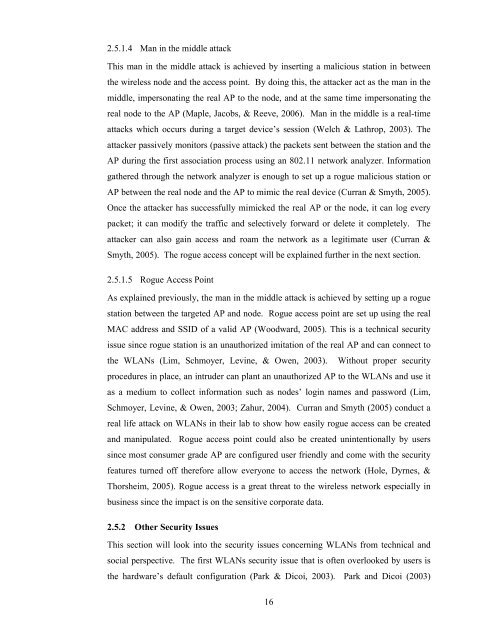AIS300 - Scheme of Work - Scholarly Commons Home
AIS300 - Scheme of Work - Scholarly Commons Home
AIS300 - Scheme of Work - Scholarly Commons Home
You also want an ePaper? Increase the reach of your titles
YUMPU automatically turns print PDFs into web optimized ePapers that Google loves.
2.5.1.4 Man in the middle attack<br />
This man in the middle attack is achieved by inserting a malicious station in between<br />
the wireless node and the access point. By doing this, the attacker act as the man in the<br />
middle, impersonating the real AP to the node, and at the same time impersonating the<br />
real node to the AP (Maple, Jacobs, & Reeve, 2006). Man in the middle is a real-time<br />
attacks which occurs during a target device’s session (Welch & Lathrop, 2003). The<br />
attacker passively monitors (passive attack) the packets sent between the station and the<br />
AP during the first association process using an 802.11 network analyzer. Information<br />
gathered through the network analyzer is enough to set up a rogue malicious station or<br />
AP between the real node and the AP to mimic the real device (Curran & Smyth, 2005).<br />
Once the attacker has successfully mimicked the real AP or the node, it can log every<br />
packet; it can modify the traffic and selectively forward or delete it completely. The<br />
attacker can also gain access and roam the network as a legitimate user (Curran &<br />
Smyth, 2005). The rogue access concept will be explained further in the next section.<br />
2.5.1.5 Rogue Access Point<br />
As explained previously, the man in the middle attack is achieved by setting up a rogue<br />
station between the targeted AP and node. Rogue access point are set up using the real<br />
MAC address and SSID <strong>of</strong> a valid AP (Woodward, 2005). This is a technical security<br />
issue since rogue station is an unauthorized imitation <strong>of</strong> the real AP and can connect to<br />
the WLANs (Lim, Schmoyer, Levine, & Owen, 2003). Without proper security<br />
procedures in place, an intruder can plant an unauthorized AP to the WLANs and use it<br />
as a medium to collect information such as nodes’ login names and password (Lim,<br />
Schmoyer, Levine, & Owen, 2003; Zahur, 2004). Curran and Smyth (2005) conduct a<br />
real life attack on WLANs in their lab to show how easily rogue access can be created<br />
and manipulated. Rogue access point could also be created unintentionally by users<br />
since most consumer grade AP are configured user friendly and come with the security<br />
features turned <strong>of</strong>f therefore allow everyone to access the network (Hole, Dyrnes, &<br />
Thorsheim, 2005). Rogue access is a great threat to the wireless network especially in<br />
business since the impact is on the sensitive corporate data.<br />
2.5.2 Other Security Issues<br />
This section will look into the security issues concerning WLANs from technical and<br />
social perspective. The first WLANs security issue that is <strong>of</strong>ten overlooked by users is<br />
the hardware’s default configuration (Park & Dicoi, 2003). Park and Dicoi (2003)<br />
16

















